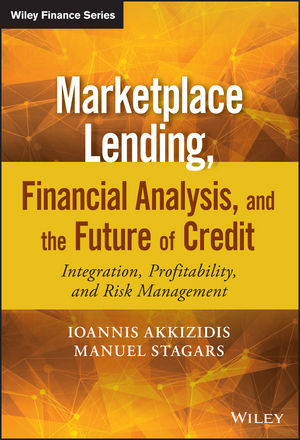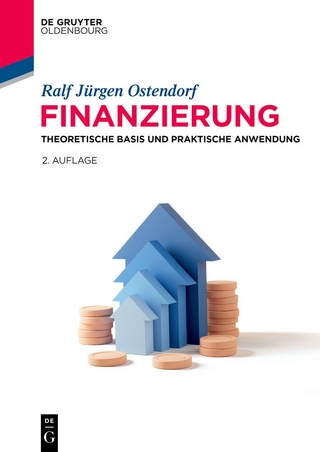
Marketplace Lending, Financial Analysis, and the Future of Credit
John Wiley & Sons Inc (Verlag)
978-1-119-09916-1 (ISBN)
The time for financial technology innovation is now Marketplace Lending, Financial Analysis, and the Future of Credit clearly explains why financial credit institutions need to further innovate within the financial technology arena. Through this text, you access a framework for applying innovative strategies in credit services. Provided and supported by financial institutions and entrepreneurs, the information in this engaging book encompasses printed guidance and digital ancillaries.
Peer-to-peer lenders are steadily growing within the financial market. Integrating peer-to-peer lending into established credit institutions could strengthen the financial sector as a whole, and could lead to the incorporation of stronger risk and profitability management strategies.
Explain (or Explore) approaches and challenges in financial analysis applied to credit risk and profitability
Explore additional information provided via digital ancillaries, which will further support your understanding and application of key concepts
Navigate the information organised into three subject areas: describing a new business model, knowledge integration, and proposing a new model for the Hybrid Financial Sector
Understand how the rise of fintech fits into context within the current financial system
Follow discussion of the current status quo and role of innovation in the financial industry, and consider the financial technology innovation landscape from the perspective of an entrepreneur
Marketplace Lending, Financial Analysis, and the Future of Credit is a critical text that bridges the gap in understanding between financial technology entrepreneurs and credit institutions.
IOANNIS AKKIZIDIS, MSc, PHD, is global product manager on financial risk management systems for Wolters Kluwer in Zurich, Switzerland. He has experience in designing and implementing advanced solutions in risk-management and profitability analysis fields for the financial industry all around the world. MANUEL STAGARS, CFA, CAIA, ERP, consults private clients on entrepreneurship, business models and financial strategy, and he is serial entrepreneur and founder of seven companies in Switzerland, the United States and Japan.
Preface xvii
Acknowledgments xix
About the Authors xxi
About the Website xxiii
Introduction 1
I.1 Who is this Book For? 2
I.2 What is Fintech? 2
I.2.1 Distinction between Financial Technology Innovation and Financial Innovation 3
I.3 Why Does this Book Focus on Online Lending? 4
I.4 The Hybrid Financial Sector: The Opportunity to Build a Healthier Financial System 5
PART ONE Fintech and Online Lending Landscape—Where Are We Now? 11
CHAPTER 1 Introduction to the Business Models in Financial Technology 15
1.1 Innovation Themes in Fintech 15
1.2 The Promises and Pitfalls of Fintech Business Models 20
1.3 The Pitfalls 22
1.4 Why is Financial Technology Innovation Important? 23
1.5 Challenges and Roadblocks for Fintech Companies 24
1.6 Fintech is a Long-Term Play 26
1.7 Concluding Remarks 27
CHAPTER 2 How Does Online Lending Work? An Overview with a Focus on Marketplace Lending 29
2.1 Reliance on Technology and Data 29
2.2 How Do Online Lenders Differ From Banks? 30
2.3 Types of Online Lenders 31
2.4 Some Background on Peer-to-Peer Networks 36
2.5 The Business Model of Marketplace Lending Platforms 40
2.6 Onboarding Process 41
2.7 Comparing Marketplace Loans with Bank Credit or Credit Card Debt 44
2.8 Who are the Alternative Borrowers? 47
2.9 Who Are Investors in Marketplace Loans? 48
2.10 Underwriting and Credit Scoring 48
2.11 Regulation 49
2.12 The Response of Banks to Online Lending 51
2.13 Concluding Remarks 52
CHAPTER 3 What Made the Rise of Online Lending Possible? 57
3.1 Technological Factors 57
3.2 Social Factors 62
3.3 Structural Factors 63
3.4 The Perfect Storm 65
3.5 A Divergence of Trends 66
3.6 Concluding Remarks 67
CHAPTER 4 Why Fintech Lives Outside of Banks 69
4.1 The Technology Mudslide Hypothesis: Sustaining Innovation vs. Disruptive Innovation 70
4.2 Will Banks Notice the Next Fintech Breakthrough? 73
4.3 Why Do Banks Have Difficulty in Innovating? 76
4.4 Developing Core Competence in Financial Technology Innovation 79
4.5 Concluding Remarks 81
PART TWO The Status Quo of Analytics in the Financial Industry—The Perspective of Banks 83
P2.1 Banking is Innovation 84
P2.2 Banking Goes Mobile 84
P2.3 Banks Are Far From Dead 85
P2.4 How to Read This Part of the Book 85
P2.5 What We Discuss in This Part 86
CHAPTER 5 Financial Contracts 89
5.1 Contract Elements 89
5.2 Time in Financial Contracts 90
5.3 Contract Mechanisms Producing Financial Events 92
5.4 Concluding Remarks 106
CHAPTER 6 Markets 107
6.1 Real-world and Risk-neutral Expectations of Markets 108
6.2 Economic Scenarios Based on Real-world Probabilities 109
6.3 The Risk-neutral Expectations 110
6.4 Beyond Market Risk-Free Rates 113
6.5 Discounting Cash Flows 116
6.6 Considering Market Elements in P2P Finance 117
6.7 Concluding Remarks 118
CHAPTER 7 Counterparties 121
7.1 Types and Roles of Counterparties 121
7.2 Descriptive Characteristics 123
7.3 Default Probability 124
7.4 Credit Ratings 129
7.5 Credit Spreads Based on Real-world Probabilities 130
7.6 Link of Counterparties via Markets 131
7.7 Concluding Remarks 137
CHAPTER 8 Behavior Risk 139
8.1 Prepayments 140
8.2 Draw-downs/Remaining Principle/Facilities and Credit Lines 141
8.3 Withdrawals 143
8.4 Selling 143
8.5 Default and Downgrading 144
8.6 Use at Default 145
8.7 Recoveries 146
8.8 Concluding Remarks 147
CHAPTER 9 Credit Exposures 151
9.1 Gross Exposure 151
9.2 Net Exposure 152
9.3 Evolution of the Gross and Net Exposures 152
9.4 Exposure Distribution 155
9.5 Credit Losses 156
9.6 Link of Counterparties via Credit Exposures 157
9.7 Concluding Remarks 158
CHAPTER 10 Credit Enhancements 161
10.1 What are Credit Enhancements? Types and Structure 162
10.2 Asset-based Credit Enhancements 162
10.3 Counterparty-based Credit Enhancements 165
10.4 Additional Elements Considered in Credit Enhancements 168
10.5 Extending Credit Enhancements in Marketplace Lending 170
10.6 Concluding Remarks 175
CHAPTER 11 Systemic and Concentration Risks 177
11.1 Credit Exposure Systemic Risk 177
11.2 Counterparty Systemic Risk 180
11.3 Systemic Risk Exposures and Losses 183
11.4 Credit Exposure Concentration Risk 184
11.5 Counterparty Concentration Risk 185
11.6 Systemic Risk and Portfolio Diversification 187
11.7 Concluding Remarks 187
CHAPTER 12 Liquidity, Value, Income, Risk and New Production 189
12.1 Liquidity 190
12.2 Value and Income 197
12.3 New Production 203
12.4 Treasury and Funds Transfer Pricing (FTP) 205
PART THREE Toward the Future of the Hybrid Financial Sector 215
P3.1 Dangers of a Big Bang Approach to Catch up with Technology Innovation 216
P3.2 The Need to Collaborate in a Hybrid Financial System 217
CHAPTER 13 Profitability and Risk of Marketplace Loans 219
13.1 Underlying Assumptions of the Analysis 220
13.2 Risk Factors 222
13.3 Portfolio Construction 224
13.4 Modeling Portfolio Performance 226
13.5 Risk Management 236
13.6 The Road Forward 246
13.7 Concluding Remarks 247
CHAPTER 14 Digital Competencies and Digital Dilemmas 251
14.1 Digital Competencies 252
14.2 Digital Dilemmas 255
14.3 Concluding Remarks 260
CHAPTER 15 Digital Strategy 263
15.1 Who Needs Digital Strategy? 263
15.2 Frameworks to Analyze the Impact of Innovation 264
15.3 Spotting Signs of Trouble on the Horizon 267
15.4 How Banks Can Overcome the Innovator’s Dilemma 269
15.5 From Producer to Supplier and Moving to a New Singularity 271
15.6 From Closed Innovation to Open Services Innovation 272
15.7 The Role of Leadership in Driving Emergent Strategy 273
15.8 Concluding Remarks 274
CHAPTER 16 The Hybrid Financial Sector 277
16.1 Forces of Competition in the Digital Age 277
16.2 The Dangers of Knife Fights 279
16.3 Good Ideas in Marketplace Lending That Might Be Here to Stay 280
16.4 The Alternative to the Hybrid Financial Sector: A Doomsday Scenario for Established Banks? 286
16.5 Concluding Remarks 286
CHAPTER 17 Unified Analytics 289
17.1 Why Do Marketplace Lending Platforms Need Unified Financial Analytics? 290
17.2 An Overview of a Unified Analytics Platform 296
17.3 Concluding Remarks 301
Bibliography 303
| Erscheint lt. Verlag | 16.2.2016 |
|---|---|
| Reihe/Serie | Wiley Finance Series |
| Verlagsort | New York |
| Sprache | englisch |
| Maße | 178 x 252 mm |
| Gewicht | 753 g |
| Themenwelt | Wirtschaft ► Betriebswirtschaft / Management ► Finanzierung |
| ISBN-10 | 1-119-09916-1 / 1119099161 |
| ISBN-13 | 978-1-119-09916-1 / 9781119099161 |
| Zustand | Neuware |
| Informationen gemäß Produktsicherheitsverordnung (GPSR) | |
| Haben Sie eine Frage zum Produkt? |
aus dem Bereich


